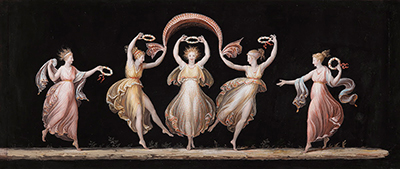Within a number of painting Canova would take his Three Graces theme into the discipline of tempera, with dancing figures decorating these pretty compositions. Relatively little is known about these artworks because most focus has always remained upon the artist's sculptures, as that was his specialisation.
Relatively little is known about a series of frescoes which Canova produced in the late 18th century. They would be amongst his last paintings, a medium in which he dabbled successfully for nearly two decades up to around that point. The artist would mention these items himself within some written documentation, commenting on nymphs and muses within scenes of dance. Canova was highly proficient as a sketcher from his early years in which this medium would form a key part of his artistic education. His paintings would therefore become an extension of that and also helped him to continue to try out different ideas around how to work with figurative art. He found that such practice would actually aid his other mediums as well, as the themes were fairly consistent across the board. Mythology, for example, would dominate his content and we find the same here again within this painting, with cupids, nymphs and the three graces.
The conflicts between Italy and France would sometimes impact the artist's work, regularly leaving him short of sculptural resources. This situation would encourage him to try out other avenues of self-expression and that is how he became interested in painting, as well as continuing to hone his talents as a draughtsman as well. Tempera was the method that he chose and this was quite a traditional approach which had been replaced by oils for most artists, but Canova felt comfortable in working this way and achieved some levels of success. Tempera produced colour from the use of egg and this approach was very common during the Italian Renaissance before the influence of North Europeans would bring about a greater use of oils instead. Canova was well trained from an early age and so was introduced to different ideas throughout his life, as well as mixing with painters as part of his time running a large studio.
Another artist who worked across different disciplines was fellow Italian, Gian Lorenzo Bernini. He was certainly an accomplished painter and desired the opportunity to fill rooms with a mixture of his work, essentially covering all the different architectural and design tasks. He was far more proficient within painting than Canova, leaving behind several dozen oil paintings, where as just a handful of Canova's still remain today. Some of his best known pieces included the likes of David, Self-Portrait as a Young Man and also this portrait of Pope Urban VIII. He also remains highly regarded today, with both men seen as amongst Italy's finest ever sculptors, with interesting contributions in other disciplines as well as part of two highly impressive oeuvres.




